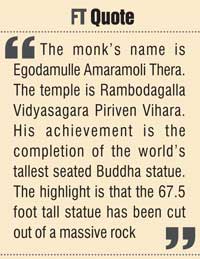Tuesday Jan 13, 2026
Tuesday Jan 13, 2026
Saturday, 16 May 2015 00:38 - - {{hitsCtrl.values.hits}}

A not-so-well-known monk in a not-so-well-known temple has done what most thought was an impossible task. True, we are in the age of technology, but what the monk has achieved is something unique done in the traditional way dating back to several centuries.
The monk’s name is Egodamulle Amaramoli Thera. The temple is Rambodagalla Vidyasagara Piriven Vihara. His achievement is the completion of the world’s tallest seated Buddha statue. The highlight is that the 67.5 foot tall statue has been cut out of a massive rock.
The closest town to the temple is Kurunegala, the capital of the North Western Province. The place has been named after a rock resembling an elephant – ‘Ath-Gala’. Kurunegala was once known as ‘Athugalpura’ – the city of the elephant rock. That was in the 13th century when the capital got shifted from one place to another.
When the ancient kings had to abandon Polonnaruwa as the capital following the Magha invasion, Vijayabahu III (1232-36) moved to Dambadeniya. Three kings ruled from there until Bhuvanekabah I (1272-84) shifted to Yapahuva. In 1293 Bhuvanekabahu II chose Kurunegala as the capital. 
Kurunegala remained the capital until 1341when Bhuvanekabahu IV decided to shift the capital to Gampola. Among the better known kings of that era was Parakramabahu IV (1302- 26), popularly referred to as Pandita Parakramabahu due to his erudition and patronage of literature.
The reason for the shifting of capitals was security and Kurunegala was considered a safer place with threats from Indian kings. There had been a fort in Kurunegala although even the ruins cannot be seen.
The monk was prompted to undertake this gigantic task after the destruction of the Bamiyan Buddha statues in Afghanistan by the Taliban extremists in 2001 following a threat by a boy in the village to start attacking Muslims. A team of craftsmen from India took 13 years to complete it.
Now that the statue has been completed, it is bound to be a popular destination of ‘vanada nades’ because it can be reached on the way to Anuradhapura. Ridi Vihara is also close by. Tourists will also find it exciting to see such a tall, rock-cut statue. For many it will be a convenient day trip.
Situated 116 kilometres from Colombo, the temple can be reached by going on the Kandy-Kurunegala road and turning off from Mallawapitiya junction and proceeding for 20 kilometres on the Keppetigala road.
Viewing the ‘modern marvel,’ one can go back to the Anuradhapura and Polonnaruwa eras when such colossal rock-cut statues were built by the Sinhalese monarchs at Avukana, Sesseruva, Gal Vihara and Buduruvagala.